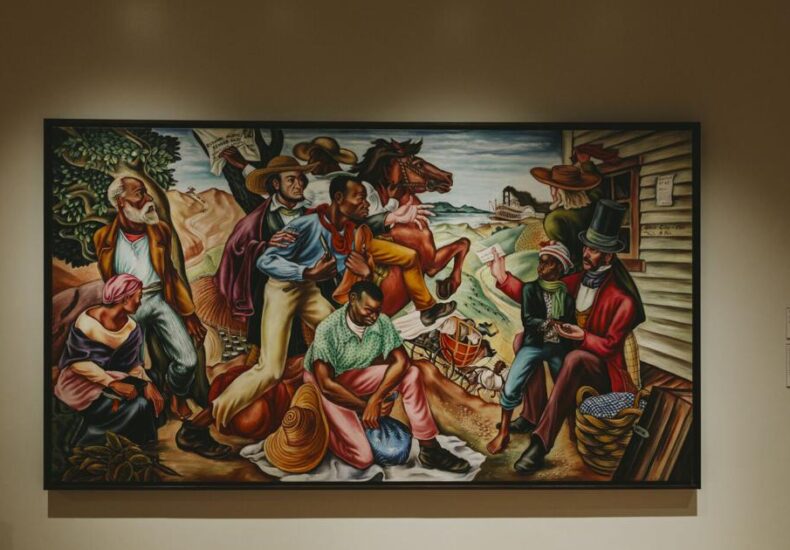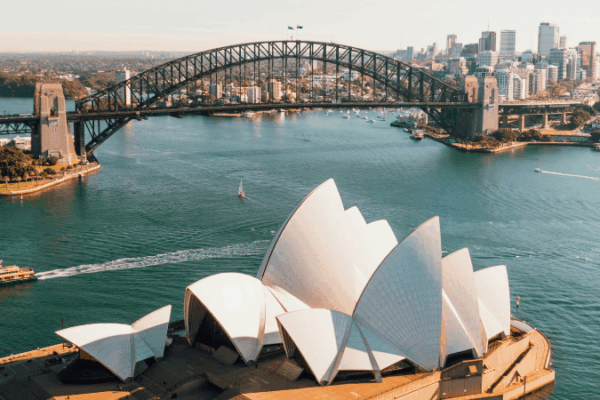
To Avert Crisis, Talladega College Sells Its Art Treasures
**Talladega College’s Priceless Murals Sold to Secure Its Future**
*TALLADEGA, Ala.* — In May 2024, soon after Rica Lewis-Payton became board chair of Talladega College, a historically Black institution in rural Alabama, she faced a crisis. The college, which has a paltry endowment of under $5 million, couldn’t meet its payroll that month.
“We had to look at every asset that we have,” Lewis-Payton, a retired hospital executive and 1981 Talladega alumna, said in an interview.
Talladega’s most outstanding asset was a group of six remarkable murals that Black artist Hale Woodruff painted there between 1939 and 1942, commemorating interracial cooperation in the African American struggle for freedom and advancement.
One mural, a swirling tableau of men overwhelming their captors on a slave ship titled *The Mutiny on the Amistad*, is the artist’s most dramatic painting. Another is an emotionally powerful depiction of the Underground Railroad, with allies of both races ushering enslaved people to liberty.
In all, “they are Woodruff’s crowning achievement, and among the best American murals,” said art historian Barbara Haskell, a longtime Whitney Museum curator.
—
Over the past year, Lewis-Payton oversaw a sale in which Talladega will relinquish ownership of four of the six Woodruff murals to the Toledo Museum of Art and two art foundations, in return for an undisclosed sum art experts estimate at $20 million.
“It required deliberate thought and execution,” Lewis-Payton said. “I sit here today feeling good that we are leveraging this most prized possession in a way that will improve the ability of the college to provide a foundational education for people like me.”
Lewis-Payton acknowledged that selling these paintings would surrender a key piece of Talladega’s legacy and potentially provoke vehement opposition. Yet college administrators realized the works were going mostly unseen.
In 2012, the murals were removed for conservation and then sent off on a four-year, eight-city tour, in what Roberta Smith, writing in *The New York Times*, called a “stunning exhibition.” Despite that exposure, once the murals returned to Talladega to be installed in a new museum building, only 500 people came annually to view them.
—
“It’s like your grandmother’s quilt,” said Willie Todd, the college president. “It’s a beautiful quilt and everyone loves it, but it’s in the attic.”
Woodruff’s three murals portraying the 1839 uprising by 53 enslaved Africans aboard the Spanish schooner La Amistad, and its aftermath, are being jointly acquired by the Art Bridges Foundation and the Terra Foundation for American Art—two nonprofits that lend American art to public institutions.
The Toledo Museum of Art is purchasing Woodruff’s later depiction of the Underground Railroad. Two other murals illustrating events in Talladega College’s history will remain at the school.
While the agreement is not yet formalized, executives at the Toledo Museum and the art foundations said they will highlight in perpetuity the murals’ connection to Talladega in wall text whenever the works are lent. They also stipulate the murals will be reunited at the college, likely every six to eight years. (Potential buyers who did not agree to these terms were disqualified.)
—
“This is going to expand the branding of our institution, and they will witness the beauty of this artwork around the world,” said Todd, who became college president in July, when the deaccession was already underway.
Lewis-Payton said that “increasing the visibility of these incredible pieces of art was a guiding principle from the very beginning.” She added, “The story isn’t being told.”
—
The murals take on powerful resonance when seen on the campus for which they were made.
Founded in 1867—briefly called Swayne School—Talladega College was established by two formerly enslaved men with the support of the racially integrated American Missionary Association, a Congregationalist organization that grew out of a committee that defended the Amistad mutineers and promoted the education of African Americans.
When Woodruff agreed in 1938 to depict the Amistad saga, the episode was so widely forgotten that he had never heard of it.
At the time, Woodruff was directing the art department at Atlanta University, another HBCU, after reluctantly returning to the United States from Paris to take the secure teaching job amid the Great Depression.
In 1937, he spent six weeks working with Diego Rivera in Mexico, learning techniques and inspired by the social activism of the great Mexican artist. However, Woodruff’s Talladega murals stylistically are closer to the rhythmic, vividly colored works of American regionalist Thomas Hart Benton.
Woodruff thoroughly researched the history of the Amistad in archives before beginning his murals, although he compressed events and invented details (such as adding his own likeness among defendants in a courtroom) when rendering the gripping tale.
—
On board the Spanish schooner, a group of Mende people enslaved in Sierra Leone took control off the coast of Cuba, killing the captain and the cook.
In Woodruff’s opening tableau, bare-chested men overwhelm their captors. Later, the ship made land in Connecticut, and after trials that reached the Supreme Court, the Africans were freed and returned to their homeland.
In huge murals—the courtroom scene is 20 feet long—Woodruff sequentially portrayed the uprising, trial, and repatriation.
Three years later, to mark the 75th anniversary of the college’s founding, Woodruff completed a second series, including the mural memorializing the Underground Railroad, along with two others.
One depicts the opening day of Talladega College, with Black men carrying livestock and crops to white administrators to pay for their tuition. The final mural centers on an event seven decades later: the construction by a racially mixed crew of Savery Library, where all the paintings were originally installed.
—
Contemplating how the murals could be removed from their original environment, Lewis-Payton sought guidance.
“I knew nothing about the art world,” she said.
She turned to James D. Thornton, a former chair of the Talladega board who is currently chair of the Baltimore Museum of Art. Thornton introduced her to art consultant Nina del Rio.
Lewis-Payton and del Rio initially considered selling all six murals as a unit to a public institution, but determined potential buyers might be unable to display so many.
They devised a partnership concept: The Amistad murals would be sold as a three-part work. The Underground Railroad painting would be sold separately. The two murals set at the college would remain.
—
Although expense cutbacks and a $15 million credit union loan have helped stabilize Talladega’s finances, underlying strains remain.
The college depends heavily on tuition fees, and enrollment has plummeted—from 1,291 in fall 2020 to 745 today.
With the sale, “We can become a leader in the reimagining of liberal arts education,” said Todd. “I want every student to graduate with an internship or apprenticeship opportunity. And I want all of our programs to be connected to industry standards and accredited by national accreditors. That takes money.”
—
Recently, there has been an influx of large donations to HBCUs.
In September, philanthropist MacKenzie Scott gave $70 million to the United Negro College Fund (UNCF), which, combined with $100 million from the Lilly Endowment Inc., will be distributed to 37 constituent HBCUs for their endowments. (Talladega will receive a $5 million infusion.)
Michael Lomax, president and chief executive of the fund and a former teacher at Morehouse and Spelman Colleges, said he hopes each college will be able to match that amount to total $10 million in fixed endowments.
When Lomax first heard that Talladega might sell the Woodruff murals, he was aghast.
“It’s not my place to tell an institution what to do, but that would be like giving up part of their soul,” he said. “I would consider the Talladega murals to be a big part of their birthright. Those paintings will not have the same meaning if they’re put in a high-design building and a place that has nothing to do with the paintings.”
—
But on reflection, and after consultation with Lewis-Payton, he softened his tone.
“What is the theme of the Amistad murals?” he said. “It is freedom. And this is allowing them to have financial freedom.”
He added, “It was a hard call, but they made the right call. They saved the institution.”
https://www.phillytrib.com/lifestyle/to-avert-crisis-talladega-college-sells-its-art-treasures/article_ef5d0014-61ba-4369-9dd6-b6fe5097bc60.html
You may also like
更多推荐
You may be interested
The incredible transformation of Elastigirl on screen
**The Incredible Transformation of Elastigirl on Screen** *By Vinita Jain...
Golden Age Thursday: T.S.O.L. Run Through Early Material During Hectic 1981 Performance In California
T. S. O. L., like any memorable punk band, has...
‘I respect all religions’: CJI after idol remarks spark row
By Chanshimla Varah | Sep 18, 2025, 04:22 PM **Chief...
 The New York Times
The New York Times
- California Gets Heavy Rain, Snarled Travel and Power Outages for Christmas 2025 年 12 月 25 日 Alexander Nazaryan and Thomas Gibbons-Neff
- $1.817 Billion Powerball Jackpot Won by Single Ticket in Arkansas 2025 年 12 月 25 日 Dan Watson and Rylee Kirk
- Christmas Around the World in Photos 2025 年 12 月 25 日 The New York Times
- Why Russia Is Likely to Reject the New US-Ukrainian Peace Plan 2025 年 12 月 25 日 Ivan Nechepurenko
- No Power, No Heat, No Water: Odesa’s Days of Hell Under Russian Fire 2025 年 12 月 25 日 Kim Barker, Oleksandra Mykolyshyn and Laetitia Vançon
- Prominent Leaders Amplify Disinformation About Brown University Shooting 2025 年 12 月 25 日 Steven Lee Myers
- With Airspace Closed, a Lonely Christmas for Many Venezuelans 2025 年 12 月 25 日 Annie Correal
- Estonia’s Man on Capitol Hill Is on a Charm Offensive 2025 年 12 月 25 日 Adam Sella
- Pope Leo Makes Christmas Call for Dialogue to Address World’s Conflicts 2025 年 12 月 25 日 Motoko Rich
- King Charles Urges ‘Compassion’ and Finding Strength in Diversity in Annual Christmas Message 2025 年 12 月 25 日 Lizzie Dearden



Leave a Reply